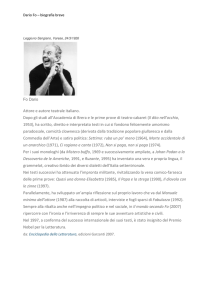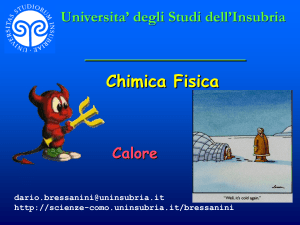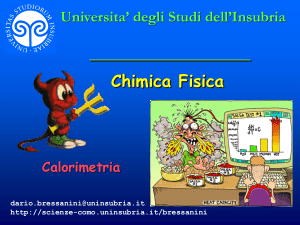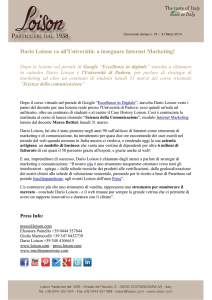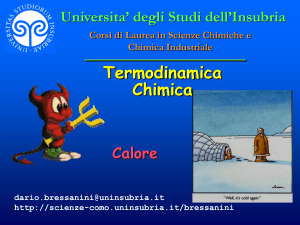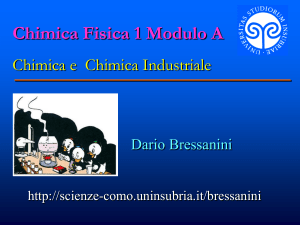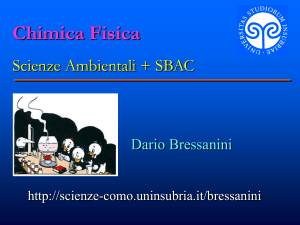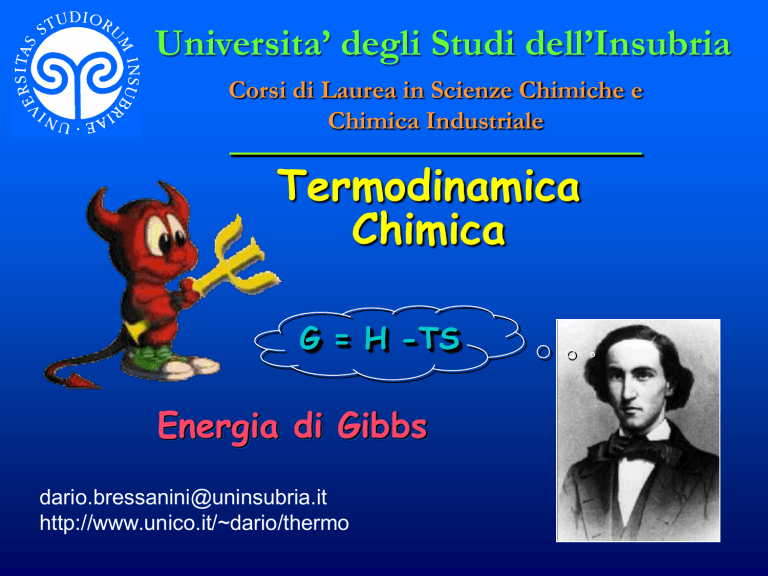
Universita’ degli Studi dell’Insubria
Corsi di Laurea in Scienze Chimiche e
Chimica Industriale
Termodinamica
Chimica
G = H -TS
Energia di Gibbs
[email protected]
http://www.unico.it/~dario/thermo
Energia di Gibbs
Processi Spontanei
Un processo è spontaneo se l’entropia
dell’Universo aumenta.
DStot = DSsis + DSamb 0
É scomodo dover esplicitamente tener conto di
quello che succede nell’Universo. Preferiremmo
concentrarci solo sul sistema.
Se lavoriamo a pressione costante o a volume
costante, è facile tener conto dei contributi
entropici dell’ambiente.
© Dario Bressanini
Processi spontanei
Partiamo dalla disuguaglianza di Clausius
dq
Processo
dS
0
spontaneo
T
Consideriamo la pressione costante: dq = dH
dH
dS
0
T
dH TdS 0
Esprime il criterio di spontaneità solo in base
a funzioni di stato del sistema.
© Dario Bressanini
Energia di Gibbs
dH – T dS 0
Se S = costante, H viene minimizzato
Se H = costante, S viene massimizzato
Introduciamo la funzione
G=H–TS
G = energia di Gibbs (un tempo ‘energia libera’)
A temperatura costante
dG = dH – T dS – S dT = dH – T dS
© Dario Bressanini
Energia di Gibbs
Se il sistema cambia a T e p costanti,
dGp,T = dH – T dS 0
All’equilibrio dGp,T = 0
Per una variazione finita, a T e p costanti
DGp,T = DH – T DS
Se il processo è spontaneo
DG < 0
All’equilibrio
DG = 0
© Dario Bressanini
Energia di Gibbs e Universo
Se p e T sono costanti
DG < 0
© Dario Bressanini
DSuniverso > 0
Energia di Gibbs e Universo
Attenzione!!
Se p e T NON sono
costanti, G e’
ugualmente definita, ma
DG NON rappresenta
piu’ la variazione di
entropia dell’Universo
© Dario Bressanini
Energia di Helmholtz
A volume costante: dq = dU
dU
dS
0
T
dU TdS 0
Introduciamo la funzione di Helmoltz
A=U–TS
A temperatura costante
dA = dU – T dS – S dT = dU – T dS
© Dario Bressanini
Le Proprieta’ di G
Giochiamo un poco con i differenziali
dG = dH – TdS - SdT
dH = dU + pdV + Vdp
dG = dU + pdV + Vdp – TdS - SdT
dU = TdS - pdV
dG = TdS - pdV + pdV + Vdp – TdS - SdT
dG = Vdp - SdT
© Dario Bressanini
Le Proprieta’ di G
dG = Vdp - SdT
Questa equazione suggerisce di considerare G
una funzione di p e T: G=G(p,T)
Questo spiega la sua importanza in Chimica
G
G
dG
dT
dP
T P
P T
G
S
T P
© Dario Bressanini
G
V
P T
Relazione di Maxwell
dG = Vdp - SdT
Poichè dG è un differenziale esatto, possiamo
ricavare un’altra relazione di Maxwell
S
V
T P
p T
© Dario Bressanini
Dipendenza dalla
Pressione
Dipendenza di G dalla pressione
La variazione di G
rispetto a p è data da
© Dario Bressanini
(G/
p)T = V
Un grafico qualitativo si
ottiene considerando che a
T costante, Liquidi e Solidi
non variano molto il loro
volume con la pressione, a
differenza dei Gas.
Variazione Isoterma
Calcoliamo la variazione di energia di Gibbs
durante una trasformazione isoterma
G
V
p T
dG Vdp T cost
Vf
G ( p f ) G ( pi ) Vdp
Vi
© Dario Bressanini
Variazione Isoterma di un Gas ideale
Per un gas ideale V = nRT/p
Vf
G ( p f ) G ( pi ) Vdp
Vi
pf
nRT
G ( pi )
dp
p
pi
© Dario Bressanini
pf
G ( p f ) G ( pi ) nRT ln
pi
Variazione Isoterma di un Gas ideale
Possiamo considerare la pressione di
riferimento p° = 1 bar
pf
G( p f ) G( p) nRT ln
p
G( p) G nRT ln p
P deve venire misurata in bar
© Dario Bressanini
Liquidi e Solidi
Solidi e Liquidi sono sostanzialmente
incomprimibili, quindi in prima approssimazione
pf
DG Vdp V ( p f pi ) VDp
pi
© Dario Bressanini
Dipendenza dalla
Temperatura
Dipendenza di G da T
La variazione di G
rispetto a T è data da
© Dario Bressanini
T)p = -S
Un grafico qualitativo si
ottiene considerando che
(G/
S(gas) >> S(liquido) > S(solido)
La fase più stabile è
quella con minor G.
Dipendenza di G da T
A pressione costante
G
dG
dT SdT
T P
G
DG
dT SdT
T P
T1
T1
T2
© Dario Bressanini
T2
Dipendenza di DG da T
Il DG di un processo può essere calcolato a
varie temperature
T2
DG T2 DG T1 DS dT
T1
DGT2 DGT1 DS T2 T1
© Dario Bressanini
Lavoro ed energia
di Gibbs
Lavoro ed Energia di Gibbs
L’Energia di Gibbs rappresenta il massimo
lavoro non di espansione ottenbile da un
processo (importante per le batterie):
dH = dU + d(pV) = dq + dw + d(pV)
Per un cambiamento reversibile dw = dwrev dq = TdS
dG = TdS + dwrev + d(pV) –TdS = dwrev + pdV + Vdp
dwrev e’ lavoro di espansione –pdV piu’ altro lavoro dwa
dG = –pdV + dwa + pdV + Vdp = dwa + Vdp
A pressione costante dG = dwa
Poiche’ il processo e’ reversibile, il lavoro e’ massimo
© Dario Bressanini
Lavoro ed Energia di Gibbs
© Dario Bressanini
Variazione di Energia di Gibbs
DG
=
DH
DH
=
DG + TDS
Energia
Disponibile
Benzina
Energia
Interna
Legami
Chimici
© Dario Bressanini
- T D S oppure
Lavoro
utilizzabile
Ruote che
girano,
batteria che
si carica,
luci…
Energia
Dispersa
Calore disperso
nell’ambiente,
che aumenta
l’entropia
dell’univrso
Efficienza
L’efficienza e’ il rapporto tra l’energia fornita
e il lavoro estratto.
Apparecchio
Batterie a secco
Caldaia domestica
Razzo a combustibile liquido
Motore di automobile
Lampada a fluorescenza
Cella solare
Lampada ad incandescenza
© Dario Bressanini
efficienza
90%
65%
50%
< 30%
20%
~10 %
5%
DG indicatore di efficienza
Per un processo non spontaneo, DG fornisce
informazioni sulla minima quantita’ di lavoro
necessaria per far avvenire il processo
© Dario Bressanini
Non e’ raggiungibile il
100% di efficienza
Crisi Energetica?
Se l’energia totale si conserva, perche’ abbiamo un
“problema energetico” ?
Tutta (o quasi) l’energia che usiamo arriva da un’unica
fonte: il Sole
Idrodinamica
Eolica
Combustibili fossili
…
Il problema e’ la degradazione delle forme di energia.
A mano a mano che trasformiamo l’energia, diminuiamo
la parte utile. Stiamo rapidamente consumando
l’energia immagazzinata nei combustibili fossili.
© Dario Bressanini
DG
Importanza di DG
DG
Fornisce la
direzione
del processo
© Dario Bressanini
Fornisce il
massimo lavoro
utilizzabile di un
processo
Energia di Gibbs e Spontaneità
Poichè G = H – TS
La variazione finita di G è
A Temperatura e pressione costante
DG = DH- D(TS)
DG = DH- TDS
DG < 0 - processo spontaneo
DG > 0 - processo non spontaneo (spontaneo
nella direzione opposta)
DG = 0 - sistema in equilibrio
© Dario Bressanini
Contributi al DG
DG = DH - TDS
Distinguiamo i due contributi alla variazione di
energia di Gibbs
Entropico (DS)
Enthalpico (DH)
.
DH DS DG
-
+
-
Processo spontaneo per ogni T
-
-
?
Processo spontaneo a basse T
+
+
?
Processo spontaneo ad alte T
+
-
+
Processo mai spontaneo per qualsiasi T
© Dario Bressanini
Mistero
DH0f (C, grafite) = 0
DH0f (C, diamante) = 1.9 kJ/mol
Watson:
Dottor Holmes, posso sapere se La Grafite e’ piu’
stabile del Diamante?
Sherlock Holmes:
Calcolando il DG, caro Watson !!!
© Dario Bressanini
Elementare Watson
Calcoliamo il DGm(298 K) per la
trasformazione da grafite in diamante
Cgrafite Cdiamante
DrHo(kJ/mol)
DrGo = DrHo - TDrSo
Som(J/mol K)
Cgrafite
0
5.740
Cdiamante
1.895
2.377
DrGo = ((1895-0) – 298.15 (2.377 – 5.740))J mol-1 = 2.898 kJ mol-1
Quindi la trasformazione diamante grafite
e’ spontanea
© Dario Bressanini
DrG°
Energia di Gibbs standard di Reazione
Le entalpie e le entropie molari standard si
possono combinare per ottenere le energie di
Gibbs molari standard
DGo = DHo - TDSo
Ad esempio, per una reazione chimica
DrGo = DrHo - TDrSo
© Dario Bressanini
DGo
DGo si riferisce a condizioni standard (1 bar)
DG condizioni non standard
DG (e DGo ) non si puo’ misurare direttamente.
Solo DH viene misurato.
Come per l’Entalpia, non esiste una scala
assoluta di G
© Dario Bressanini
DS°
DH° < 0
DS° > 0
DH° > 0
DS° > 0
Spontanea a
ogni temperatura
Spontanea ad
alta temperatura
DH° < 0
DS° < 0
DH° > 0
DS° < 0
Spontanea a
bassa temperatura
Mai spontanea
© Dario Bressanini
Esotermica
Endotermica
DH°
Energia di Gibbs standard di Formazione
Il DrGo si puo’ esprimere in funzione delle
energie di Gibbs di formazione
D r G nD f Gprodotti mD f Greagenti
DfG e’ l’energia di Gibbs standard per la
formazione di un composto a partire dagli
elementi nei loro stati standard
© Dario Bressanini
Esercizio
Calcolare il DGo per la combustione
dell’Acetilene
C2H2(g) + 5/2 O2(g) 2 CO2(g) + H2O(g)
Dalle entalpie standard di formazione: DrHo = -1238 kJ
Dalle entropie molari standard: DrSo = - 0.0974 kJ/K
Calcolo DrGo = DrHo - TDrSo
DrGo = -1238 kJ - (298 K)(-0.0974 kJ/K) = -1209 kJ
La reazione e’ spontanea, nonostante il valore negativo di
DrSo.
© Dario Bressanini
Esercizio
Quando la reazione e’ spontanea ?
2 Fe2O3(s) + 3 C(s) 4 Fe(s) + 3 CO2(g)
DrHo = +467.9 kJ
DrSo = +560.3 J/K
A 298 K DrGo = 467.9 kJ - (298K)(0.560kJ/K) = +300.8 kJ
La reazione e’ sfavorita
Calcoliamo quando DrGo = 0 = DrHo - TDrSo
T = DrHo/DrSo ~ 468kJ/0.56kJ/K = 836 K o 563oC
© Dario Bressanini
DG e Temperatura
Ca(s) + Cl2(g) CaCl2(s)
DH = 59.8 kJ DS = 273 J/K
DG = DH TDS La reazione e’
Spontanea a basse T: DG < 0
Non spontanea a alte T, l’entropia prende il sopravvento
Quando DG = 0 la reazione non e’ spontanea in
entrambe le direzioni. Abbiamo una situazione di
equilibrio!
59.8 kJ T(0.273kJ/K) = 0
T = 219K or 53oC
La reazione e’ spontanea per T < 53oC
© Dario Bressanini
DG e Temperatura
C6H12O6(s) 2 C2H5OH(l) + 2 CO2(g)
DH = 70 kJ DS = +780J/K
0 = 70kJ T(+0.78J/K) T = 90K
La reazione e’ spontanea a tutte le
temperature.
Servirebbe una temperatura IMPOSSIBILE
per rendere spontanea la reazione inversa
© Dario Bressanini
Equazione di
Gibbs-Helmholtz
Dipendenza di G dalla Temperatura
G
S
T p
Partiamo dall’equazione
Riscriviamo l’entropia in funzione di G e H
H G
G H TS S
T
Calcoliamo ora
H G
G
T
T p
G
T T p
G
1 G
G 1 G G
2
T T p T T p T
T T p T
© Dario Bressanini
Equazione di Gibbs-Helmholtz
T
1 G G
G
T p T T p T
Sostituiamo la relazione
H G
G
T
T p
G
H
2
T
T T p
La variazione di G/T con T e’ piu’ semplice della variazione
di G con T
© Dario Bressanini
Bio
Vita e reazioni Spontanee
Negli esseri viventi avvengono milioni di
reazioni non spontanee. Come e’ possibile?
ATP
© Dario Bressanini
ATP = AdenosinTrifosfato
L’ATP e’ la banca di energia del corpo umano.
La reazione di Idrolisi ATP ADP e’
spontanea.
Quando il corpo ha bisogno di energia (per
flettere un muscolo, sintetizzare una proteina, etc…)
accoppia una idrolisi dell ATP con la reazione
desiderata (e un enzima opportuno)
Il metabolismo del Glucosio ritrasforma ADP
(AdenosinDifosfato) in ATP, che viene
immagazzinato
© Dario Bressanini
© Dario Bressanini
ATP e reazioni BioChimiche
Accoppiamento di reazioni non
spontanee con l’idrolisi dell’ATP
© Dario Bressanini
ATP e Energia di Gibbs
–CH2CH2COOH + NH3 –CH2CH2CONH2 + H2O
La reazione tra acido glutammico (un aminoacido) e
l’ammoniaca non e’ spontanea (DG > 0)
Nella cellula questa reazione avviene grazie
all’accoppiamento con l’idrolisi dell’ATP che fornisce
l’energia libera di Gibbs necessaria
© Dario Bressanini
ATP e Energia di Gibbs
Reazione non
spontanea
Fosforilazione dell’acido
glutammico. Reazione
spontanea
L’energia del gruppo
fosfato viene usata per
far avvenire la reazione
La reazione globale ha un
DG negativo, e quindi e’
spontanea
© Dario Bressanini
ATP e Termodinamica
Ilya Prigogine (Premio Nobel 1977)
Termodinamica del Non Equilibrio. ATP
Peter Mitchell (Premio Nobel 1978)
Meccanismi di formazione dell’ATP
© Dario Bressanini
Potenziale
Chimico
Il Potenziale Chimico
Cominciamo a considerare anche il numero di
moli una quantita’ variabile.
Definiamo il potenziale chimico
G
n T , p
Dato che G = n Gm, per una sostanza pura
(nGm )
Gm
n T , p
© Dario Bressanini
Il Potenziale Chimico
Per una sostanza pura = Gm
Definiamo il potenziale chimico standard
°= (T, 1 bar)
Per un gas ideale possiamo scrivere
RT ln p
Ricordatevi che p si intende p/1 bar
© Dario Bressanini
The End
Standard Gibbs Energy of Formation
The standard Gibbs energy of formation is the standard reaction Gibbs
energy of formation of a compound from its elements in their reference
states.
Just like enthalpy, the standard Gibbs energy of a reaction can be found
using the standard
for products and reactants.
D G θ Gibbs
νenergy
D G θ of formation
νD G θ
r
products
f
m
f
m
reactants
D r H θ TD r S θ
What is DrG298 for the combustion of methane?
CH4 (g) +2O2 (g) 2H2O (l) + CO2 (g)
D r G θ D f G θ CO2 ( g ) 2D f G θ H 2O (l )
D f G θ CH4 ( g ) 2D f G θ O 2 ( g )
394 2237 50.7 20 kJ mol-1
817 kJ mol-1
© Dario Bressanini
The Gibbs Energy Change (cont’d)
For the methane combustion reaction
1 CH4(g) + 2 O2(g) 1 CO2(g) + 2 H2O(l)
DrG = np DfG (products) - nr DfG (reactants)
= 2 DfG [H2O(l)] + 1 DfG [CO2(g)] - (7/2 DfG [O2(g)]
+ 1 DfG [CH4(g)] )
© Dario Bressanini
Free Energy Change, DG,
and Spontaneity
Example 15-16: Calculate DGo298 for the reaction in
Example 15-8. Use appendix K.
C 3 H 8 g + 5 O 2 g 3 CO 2 g + 4 H 2 O l
you do it
© Dario Bressanini
The Temperature
Dependence of Spontaneity
Example 15-17: Calculate DSo298 for the following reaction.
In example 15-8, we found that DHo298= -2219.9 kJ, and in
Example 15-16 we found that DGo298= -2108.5 kJ.
C3H8g +5 O2g 3 CO2g +4 H2Ol
© Dario Bressanini
The Temperature
Dependence of Spontaneity
Example 15-17: Calculate DSo298 for the following reaction.
In example 15-8, we found that DHo298= -2219.9 kJ, and in
Example 15-16 we found that DGo298= -2108.5 kJ.
C3H8g +5 O2g 3 CO2g +4 H2Ol
DG DH TDS
o
o
o
TDS DH DG
o
© Dario Bressanini
o
o
The Temperature
Dependence of Spontaneity
C3H8g + 5 O2g 3 CO2g + 4 H2Ol
DG DH TDS
o
o
o
TDS DH DG
o
o
DH DG
DS
T
22199
. (21085
. ) kJ
298 K
0374
. kJ K or - 374 J K
o
o
© Dario Bressanini
o
o
The Temperature
Dependence of Spontaneity
DSo298 = -374 J/K which indicates that the disorder of the
system decreases .
For the reverse reaction,
3 CO2(g) + 4 H2O(g) C3H8(g) + 5 O2(g)
DSo298 = +374 J/K which indicates that the disorder of the
system increases .
© Dario Bressanini
The Temperature
Dependence of Spontaneity
Example 15-18: Use thermodynamic data to estimate the
normal boiling point of water.
H 2 O l H 2 O g
equilibrium at BP DG = 0
DG = DH - TDS or DH = TDS
© Dario Bressanini
DH
T=
DS
The Temperature
Dependence of Spontaneity
assume DH@ BP
DH
o
o
DH H 2O(g)
o
DH 298
o
DH H 2O( l )
DH 2418
. ( 2858
. )
o
DH 44.0 kJ@25 C
o
© Dario Bressanini
o
J
K
The Temperature
Dependence of Spontaneity
assume DS@ BP
DS
o
o
SH 2O(g)
o
DS298
o
S H 2O( l )
DS 188.7 69.91
o
DS
o
J
118.8
© Dario Bressanini
K
or
J
K
kJ
- 0.1188
K
The Temperature
Dependence of Spontaneity
DH DH
44.0 kJ
T= o
370
K
kJ
DS DS 0.1188 K
o
o
370 K-273 K=97 C
© Dario Bressanini
Calculating
Go from Enthalpy and Entropy Values–I
Problem: Potassium chlorate, one of the common oxidizing agents in
explosives, fireworks, and matchheads, undergoes a solid-state redox
reaction when heated, in which the oxidation number of Cl in the reactant
is higher in one of the products and lower in the other
(disproportionation):
4 KClO
3 KClO + KCl
3 (s)
4 (s)
(s)
Use Hof and So values to calculate Gosys ( Gorxn) at 25oC for this
reaction.
Plan: To solve for Go, use Hof values to calculate Horxn( Hosys),
use So values to calculate Sorxn( Sosys), and apply Equation 20.6.
Solution: Calculating Hosys from Hof values (with Equation 6.8):
Hosys =
Horxn = ∑m
Hof(products)
∑n
Hof(reactants)
= [3 mol KClO4 ( Hof of KClO4) + 1 mol KCl (
o of KClO )]
[4
mol
KClO
(
H
3
f
3
© Dario Bressanini
Hof of KCl)]
Calculating
Go from Enthalpy and Entropy Values–II
Hosys = [3 mol (-432.8 kJ/mol) + 1 mol (-436.7 kJ/mol)]
- [4 mol (-397.7 kJ/mol)]
= -144 kJ
Calculating
Sosys =
Sosys from So values (with Equation 20.3):
Sorxn = [3 mol KClO4 ( So of KClO4) + 1 mol KCl ( So of KCl)]
- [4 mol KClO3 (So of KClO3)]
= [3 mol (151.0 J/mol K) + 1 mol (82.6 J/mol K)]
- [4 mol (143.1 J/mol K)]
= - 36.8 J/K
.
Calculating
Gosys =
.
.
Gosys at 298 K:
Hosys - T Sosys = -144 kJ - [(298 K)(-36.8 J/K)(1kJ/1000 J)]
The reaction is spontaneous which is
o
G sys = -133 kJ
© Dario Bressanini
consistent with Go < 0
Effect of Temperature on Reaction Spontaneity
The temperature at which a reaction occurs influences the magnitude of
the T S term. By scrutinizing the signs of H and S, we can predict
the effect of temperature on the sign of G and thus on the spontaneity
of a process at any temperature.
Temperature-independent cases (opposite signs)
1. Reaction is spontaneous at all temperatures:
Ho < 0, So > 0
2 H2O2 (l)
2 H2O(l) + O2 (g)
Ho = -196 kJ and
So = 125 J/K
2. Reaction is nonspontaneous at all temperatures: Ho > 0, So < 0
3 O2 (g)
2 O3 (g)
Ho = 286 kJ and So = - 137 J/K
Temperature-dependent cases (same signs)
3. Reaction is spontaneous at higher temperature: Ho > 0 and So > 0
2 N2O(g) + O2 (g)
4 NO(g)
Ho = 197.1 kJ and
So = 198.2 J/K
4. Reaction is spontaneous at lower temperature: Ho < 0 and So < 0
o = - 822.2 kJ and
o = - 181.7 J/K
Dario Bressanini
2© Na
+
Cl
2
NaCl
H
S
(s)
2 (g)
(s)
Determining the Effect of Temperature on
Go–I
Problem: An important reaction in the production of sulfuric acid is the
oxidation of SO2 (g) to SO3 (g):
2 SO
+O
2 SO
2 (g)
2 (g)
3 (g)
At 298 K, Go = -141.6 kJ;
Ho = -198.4 kJ; and So = -187.9 J/K.
(a) Use the data to decide if this reaction is spontaneous at 25oC and how
Go will change with increasing T.
(b) Assuming Ho and So are constant with T, is the reaction
spontaneous at 900.oC?
Plan: (a) We examine the sign of Go to see if the reaction is
spontaneous and the signs of Ho and So to see the effect of T.
(b) We use Equation 20.6 to calculate Go from the given Ho and
So at the higher T (in K).
Solution: Continued on next slide.
© Dario Bressanini
Determining the Effect of Temperature on
Go–II
Solution: (a) Since Go < 0, the reaction is spontaneous at 298 K: a
mixture of SO2 (g), O2 (g), and SO3 (g) in their standard states (1 atm) will
spontaneously yield more SO3 (g). With So < 0, the term -T So > 0 and
becomes more positive at higher T. Therefore, Go will be less negative,
and the reaction less spontaneous, with increasing T.
(b) Calculating
Go =
Ho - T
= 22.0 kJ
Since
Go at 900.oC (T= 273 + 900. = 1173 K):
So = - 198.4 kJ - [(1173 K)(-187.9 J/K)(1 kJ/1000 J)]
Go > 0, the reaction is nonspontaneous at higher T.
© Dario Bressanini
Calculating
G at Nonstandard Conditions–I
Problem: The oxidation of SO2, which we discussed earlier, is too slow
2 SO2 (g) + O2 (g)
2 SO3 (g)
at 298 K to be useful in the manufacture of sulfuric acid. To overcome
this low rate, the process is conducted at an elevated temperature.
(a) Calculate K at 298 K and at 973 K.
Go298 = -141.6 kJ/mol of
reaction as written; using
Ho and So values at 973 K,
Go973 = -12.12 kJ/mol of reaction as written.
(b) In experiments to determine the effect of temperature on reaction
spontaneity, sealed containers are filled with 0.500 atm SO2,
0.0100 atm O2, and 0.100 atm SO3 and kept at 25oC and at 700oC. In
which direction, if any, will the reaction proceed to reach equilibrium at
each temperature?
(c) Calculate G for the system in part (b) at each temperature.
Plan: (a) We know
Go, T, and R, so we can calculate the K’s from
Equation 12.10.
Dario Bressanini
(b)©Calculate
Q, and compare it with each K from part (a).
Calculating
G at Nonstandard Conditions–II
Plan : Continued
(c) Since these are not standard-state pressures, we calculate G at each
T from Equation 20.11 with the values of Go (given) and Q [found in
part (b)].
Solution: (a) Calculating K at the two temperatures:
Go = -RT ln K
so K = e-( G/RT)
At 298 K, the exponent is
1000 J
-141.6 kJ/mol x
1 kJ
- ( Go/RT) = = 57.2
8.31 J/mol K x 298 K
K = e-( G/RT) = e57.2 = 7 x 1024
So At 973 K, the exponent is
-12.12 kJ/mol x 1000 J
1 kJ
- ( Go/RT) = = 1.50
8.31 J/mol K x 973 K
.
.
© Dario Bressanini
K = e-(
G/RT)
= e1.50 = 4.5
Calculating
G at Nonstandard Conditions-III
(b) Calculating the value of Q :
2
p2SO3
0.100
Q= 2
=
= 4.00
2
p SO2 x pO2 0.500 x 0.0100
Since Q < K at both temperatures, the denominator will decrease and the
numerator increase–more SO3 will form–until Q equals K. However, at
298 K, the reaction will go far to the right before reaching equilibrium,
whereas at 973 K, it will move only slightly to the right.
(c) Calculating
G, the nonstandard free energy change, at 298 K and
973 K
G298 = Go + RT ln Q
= -141.6 kJ/mol + (8.31 J/mol K x 1 kJ x 298 K x ln 4.00)
1000 J
= -138.2 kJ/mol
.
G973 = Go + RT ln Q
= - 12.12 kJ/mol + (8.31 J/mol K x 1 kJ x 973 K x ln 4.00
1000 J
© Dario Bressanini
= - 0.90 kJ/mol
.
© Dario Bressanini
Fig.
20.12
Calculating DGorxn for NH4NO3(s)
EXAMPLE 2:
NH4NO3(s) NH4NO3(aq)
Is the dissolution of ammonium nitrate
product-favored?
If so, is it enthalpy- or entropy-driven?
© Dario Bressanini
9_amnit.mov
20 m07vd1.mov
DGorxn for NH4NO3(s) NH4NO3(aq)
From tables of thermodynamic data we
find
DHorxn = +25.7 kJ
DSorxn = +108.7 J/K or +0.1087 kJ/K
DGorxn = +25.7 kJ - (298 K)(+0.1087
kJ/K)
= -6.7 kJ
Reaction is product-favored
© Dario Bressanini
o
Calculating DGorxn
DGorxn = DGfo (products) - DGfo (reactants)
EXAMPLE 3: Combustion of carbon
C(graphite) + O2(g) CO2(g)
DGorxn = DGfo(CO2) - [DGfo(graph) +
DGfo(O2)]
DGorxn = -394.4 kJ - [ 0 + 0]
Note that free energy of formation of an
element in its standard state is 0.
© Dario Bressanini
o
DGo for COUPLED CHEMICAL REACTIONS
Reduction of iron oxide by CO is an example of
using TWO reactions coupled to each other in order
to drive a thermodynamically forbidden reaction:
Fe2O3(s) 4 Fe(s) + 3/2 O2(g)
DGorxn = +742 kJ
with a thermodynamically allowed reaction:
3/2 C(s) + 3/2 O2 (g) 3/2 CO2(g)
Overall :
DGorxn = -592 kJ
Fe2O3(s) + 3/2 C(s) 2 Fe(s) + 3/2 CO2(g)
DGorxn= +301 kJ @ 25oC
BUT
DGorxn < 0 kJ for T > 563oC
See Kotz, pp933-935 for analysis of the thermite reaction
© Dario Bressanini
Other examples of coupled reactions:
Copper smelting
Cu2S (s) 2 Cu (s) + S (s)
Couple this with:
S (s) + O2 (g) SO2 (s)
Overall:
DGorxn= +86.2 kJ
(FORBIDDEN)
DGorxn= -300.1 kJ
Cu2S (s) + O2 (g) 2 Cu (s) + SO2 (s)
DGorxn= +86.2 kJ + -300.1 kJ = -213.9 kJ (ALLOWED)
Coupled reactions VERY COMMON in Biochemistry :
e.g. all bio-synthesis driven by
ATP ADP for which DHorxn = -20 kJ
DSorxn = +34 J/K
DGorxn = -30 kJ @ 37oC
© Dario Bressanini
Thermodynamics and Keq (2)
9_G_NO2.mov
20m09an1.mov
© Dario Bressanini
2 NO2 N2O4
DGorxn = -4.8 kJ
pure NO2 has DGrxn < 0.
Reaction proceeds until DGrxn = 0
- the minimum in G(reaction) see graph.
At this point, both N2O4 and
NO2 are present, with more
N2O4.
This is a product-favored
reaction.
Thermodynamics and Keq (3)
N2O4 2 NO2
DGorxn = +4.8 kJ
9_G_N2O4.mov
20m09an2.mov
© Dario Bressanini
pure N2O4 has DGrxn < 0.
Reaction proceeds until DGrxn
= 0 - the minimum in
G(reaction) - see graph.
At this point, both N2O4 and
NO2 are present, with more
NO2.
This is a reactant-favored
reaction.
Thermodynamics and Keq (5)
DGorxn = - RT lnK
Calculate K for the reaction
N2O4 2 NO2
DGorxn = +4.8 kJ
DGorxn = +4800 J = - (8.31 J/K)(298 K) ln K
4800 J
lnK = = - 1.94
(8.31 J/K)(298K)
K = 0.14
When DGorxn > 0, then K < 1 - reactant favoured
When DGorxn < 0, then K >1 - product favoured
© Dario Bressanini
Consider the synthesis of methanol:
CO(g) + H2(g) CH3OH(l)
Calculate DG at 25 oC for this reaction
where CO(g) at 5.0 atm and H2(g) at 3.0 atm
are converted to CH3OH(l) .
Given:
DGf
(CH3OH(l))
DGf
(CO(g))
DGf
(H2(g))
−166 kJ
−137 kJ
0
Cont’
We must use:
DG = DG + RT ln(Q)
DG DGf
DGf
DGf
(CH3OH(l))
(CO(g))
(H2(g))
DG 166137029kJ
Q=
1
PCO . P2H2
=
1
(5) . (3)2
=
2.2 x 10-2
DG = 29x 103 + (8.3145)(298) ln( 2.2 x 10-2)
= − 38 kJ / mol
The second law is the greatest good and the
greatest bad on earth.
© Dario Bressanini
The good: Life is possible.
We eat concentrated energy in the form of food, process that
energy to synthesize complex biochemicals and run our organism,
excreting diffused energy as body heat and less concentrated
energy substances.
We use concentrated energy fuels to gather all kinds of materials
from all parts of the world and, without any energetic limitation,
arrange them in ways that please us.
We affect non-spontaneous reactions (pure metals from ores,
synthesizing curative drugs from simple compounds, altering
DNA).
We make machines that make other machines, machines that
© Dario Bressanini
mow
lawns, move mountains, and go to the moon.
The bad: Life is always threatened.
Every organic chemical of the 10,000 different kinds in our bodies
is metastable, synthesized by a nonspontaneous reaction and
kept from instant oxidation in air by activation energies.
Living creatures are energy processing systems that cannot
function unless biochemical cycles operate synchronically to use
energy to oppose second law predictions.
All of the biochemical systems that run our bodies are maintained
and regulated by feedback subsystems, composed of complex
substances that are synthesized internally by thermodynamically
nonspontaneous reactions, affected by utilizing energy ultimately
transferred from the metabolism of food. When these feedback
subsystems fail energy can no longer be processed to carry out the
many reactions we need for life that are contrary to the direction
© Dario Bressanini
predicted
by the second law.
GT,p
S
time
Changes in entropy of an isolated system with time.
with time until equilibrium is reached
Entropy increases
Change in the Gibbs free energy at constant temperature and pressure.
Under these conditions G decreases during the course of a spontaneous
change until equilibrium is reached.
© Dario Bressanini
Gibbs Free Energy
© Dario Bressanini
Chemical Potentials of the Ideal
Gas
Differentiating the chemical potential with
temperature
J
Sm,J
T P
P
Sm ,J T S m ,J T R ln P
© Dario Bressanini
The Standard Chemical Potential
For P1 = P = 1 bar, we define the standard
state chemical potential
°= (T, 1bar)
P
(T) (T, 1 bar ) RT ln
1 bar
© Dario Bressanini
The Chemical Potential for Real
Gases
The fugacity (f) represents the chemical
potential of a real gas.
Define the fugacity coefficient
=f/P
For a real gas
P
(T) (T, 1 bar ) RT ln f
© Dario Bressanini
Obtaining Fugacity Coefficients
Comparing the chemical potential of the real
gas to the chemical potential of an ideal gas at
the same pressure
P
RT ln P
P
real id RT ln f
© Dario Bressanini
Calculating Fugacity Coefficients
The fugacity coefficients are obtained from
the compression factors (Z) as shown below
Z 1
RT ln
dP
P
0
P
© Dario Bressanini
Partial molar (molal) quantities
If system is not simple, e.g. open system or
mixtures, then for e.g. substances A and B
V
dV (T , P, nA , nB )
T P ,n
A ,nB
V
V
dP
dnA
dnB
n
n
A T , P ,n
B T , P ,n
A ,nB
V
dT
P T ,n
B
A
(see lab manual, the five pages following error analysis)
For constant T,P and nA (e.g. 1 kg water in expt 2)
V
dV
dn
nB T , P ,n B
A
Find V does not vary
linearly with nB
V
Slope
V
V B Vm,B
=
n
B T , P ,n
A
partial molar volume
mB = moles solute / kg solvent
© Dario Bressanini
V
dV (T , P, nA , nB )
T P ,n
A ,nB
V
V
dP
dnA
dnB
n
n
A T , P ,n
B T , P ,n
A ,nB
V
dT
P T ,n
B
Note: at constant T and P, the total volume of the solution is:
nA
dV 0 0 V dn
A
0
A
nB
VBdnB
0
Vm,A, Vm,B are constant for a given composition
i.e. think of making up a solution at constant composition.
Then
V = Vm,A nA + Vm,B nB
A similar equation applies for any partial molar quantity.
© Dario Bressanini
A
DEFINE the chemical potential,
or partial molar free energy, of A
The exact differential for G is
G
dG(T , P, nA , nB )
T P ,n
A ,nB
G
A
nA T , P ,n
B
G
G
dP
dnA
dnB .......
n
n
A T , P ,n
B T , P ,n
A ,nB
G
dT
P T ,n
Compare with combined law eqn (CL.G)
G
G
S
dw
, V
dG + SdT - VdP = dw rev
T
P
dG = - SdT + VdP + idni
G=A+PV
dA+PdV+VdP = - SdT + VdP + idni
dA = -PdV - SdT + idni
and
A
G
U
H
A
nA T ,V ,nB nA T , P ,nB nA S ,V ,nB nA S , P ,nB
this the most useful defn., as it is the only one written in
terms of intensive variables.
B
A
P , nA , nB
© Dario Bressanini
T , nA , nB
recall:
Criteria for equilibrium:
dG = - SdT + VdP + idni
(dG) T , P i dni dw'
i
For a reversible, equilibrium process (we’ll take dw 0
such as a phase change or chemical reaction (at const. T, P)
dn
(
i
ice
i
i
0
liquid )dn = 0
i.e. equilibrium requires
ice liquid
Hence criteria for equilibrium
equal T
equal P mechanical equil
equal
© Dario Bressanini
thermal equil
chemical equil
ice
liquid
dnice = dnliquid

